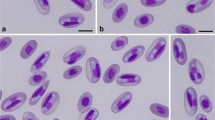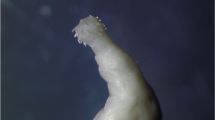Abstract
The humpback whale (Megaptera novaeangliae) is a cosmopolitan migratory, seasonal mysticete that frequents the Brazilian coast. Strands of specimens may occur during the migratory stay in the country. In 2021 and 2022, three live humpback whales stranded on the coast of Rio Grande do Sul and Santa Catarina states in southern Brazil. After euthanasia, specimens were necropsied, and organs were thoroughly examined for lesions. Grossly, in all three cases, the liver exhibited multifocal, irregular, firm, white areas on the hepatic capsule, which extended into the parenchyma. On the cut surface, the livers were yellow to pale brown with orangish to greenish areas, the bile ducts were prominent, thickened, and severely dilated, and leaf-shaped flukes were found inside of them. Additionally, one case showed moderate atrophy of the right hepatic lobe. The histological findings included dilation of bile ducts, hyperplasia of the bile duct epithelium, marked inflammatory infiltration of lymphocytes, plasma cells, and eosinophils, and portal fibrosis. The parasite Brachycladium goliath was both morphologically and molecularly identified based on diagnostic key for trematodes and the original description of the species, and the amplification and sequencing of the ITS-2 region, respectively. Even though hepatic injury was not the primary cause of stranding, it may have contributed to the debilitation of the whales. To the authors’ knowledge, this is the first study that reports M. novaeangliae as a definitive host of B. goliath and that describes the lesions caused by the parasite in cetaceans.




Similar content being viewed by others
Data availability
The datasets generated and analyzed during the current study are available from the corresponding author upon reasonable request.
References
Altschup SF, Gish W, Miller W et al (1990) Basic local alignment search tool. J Mol Biol 215:403–410
Anderson GR, Barker SC (1998) Inference of phylogeny and taxonomy within the Didymozoidae (Digenea) from the second internal transcribed spacer (ITS2) of ribosomal DNA. Syst Parasitol 41:87–94
Aznar FJ, Balbuena JA, Fernandez M, Raga’ JA (2002) Living together: the parasites of marine mammals. In: Evans PGH, Antonio Raga J (eds) Marine mammals: biology and conservation, 1st edn. Kluwer Academic/Plenum Publishers, UK, pp 385–421
Balbuena JA, Aznar FJ, Fernández M, Raga JA (1995) Parasite as indicators of social structure and stock identity of marine mammals. Dev Mar Biol 4:133–139
Bamford CCG, Jackson JA, Kennedy AK et al (2022) Humpback whale (Megaptera novaeangliae) distribution and movements in the vicinity of South Georgia and the South Sandwich Islands Marine Protected Area. Deep Sea Res 2 Top Stud Oceanogr 198:1–16. https://doi.org/10.1016/j.dsr2.2022.105074
Briscoe AG, Bray RA, Brabec J, Littlewood DTJ (2016) The mitochondrial genome and ribosomal operon of Brachycladium goliath (Digenea: Brachycladiidae) recovered from a stranded minke whale. Parasitol Int 65:271–275. https://doi.org/10.1016/j.parint.2016.02.004
Clapham PJ, Mead JG (1999) Mammalian Species: Megaptera novaeangliae. Amer Soc Mammal 604:1–9
Cullen JM, Stalker MJ (2016) Liver and biliary system. In: Maxie MG (ed) Jubb, Kemmedy, and Palmer’s pathology of domestic animals, 6th edn. Elsevier, Guelph, pp 258–352
Dailey MD (2007) A new species of digenea (Trematoda: Brachycladiidae) from the Gervais’ beaked whale, Mesoplodon europaeus, with comments on other cetacean liver flukes. Comp Parasitol 74:229–232. https://doi.org/10.1654/4250.1
Dailey MD, Hoffman KAO (1982) Parasites as biological indicators of the distributions and diets of marine mammals common to the eastern Pacific. National Oceanic and Atmospheric Administration, Administrative report LJ-82-3C 1–44
Dracz RM, Ribeiro VMA, de Pereira CAJ, dos Lima WS (2016) Ocorrência de Fasciola hepatica (Linnaeus, 1758) em capivara (Hydrochoerus Hydrochaeris) (Linnaeus, 1766) em Minas Gerais, Brasil. Rev Bras Parasitol Vet 25:364–367. https://doi.org/10.1590/S1984-29612016021
Fernandez M, Balbuena JA, Pertusa JF, Raga JA (1995) Biometric variability of Hadwenius Tursionis (Marchi, 1873) (Digenea, Campulidae) from the intestine of the bottlenose dolphin Tursiops truncatus (Montagu, 1821). Syst Parasitol 30:67–76
Fraija-Fernández N, Aznar FJ, Raga JA et al (2014) A new brachycladiid species (Digenea) from Gervais’ beaked whale Mesoplodon europaeus in north-western Atlantic waters. Acta Parasitol 59:510–517. https://doi.org/10.2478/s11686-014-0274-7
Fraija-Fernández N, Aznar FJ, Fernández A et al (2016) Evolutionary relationships between digeneans of the family Brachycladiidae Odhner, 1905 and their marine mammal hosts: a cophylogenetic study. Parasitol Int 65:209–217. https://doi.org/10.1016/j.parint.2015.12.009
Geraci JR, Lounsbury VJ (2005) Marine mammals ashore. In: A field guide for strandings, 2nd edn. National Aquarium in Baltimore, Baltimore
Gibson DI (2005) Family Brachycladiidae Odhner 1905. In: Jones A, Bray RA, Gibson DI (eds) Keys to the Trematoda, 1st edn. CABI Publishing and The Natural History Museum, Wallingford, pp 641–652
Groch KR, Díaz-Delgado J, Marcondes MCC et al (2018) Pathology and causes of death in stranded humpback whales (Megaptera novaeangliae) from Brazil. PLoS ONE 13:1–19. https://doi.org/10.1371/journal.pone.0194872
Harms CA, Greer LL, Whaley J, Rowles TK (2018) Euthanasia. In: Gulland FMD, Dierauf LA, Whitman KL (eds) Marine mammal medicine, 3rd edn. CRC Press, Boca Raton, pp 675–691
Hermosilla C, Silva LMR, Prieto R et al (2015) Endo- and ectoparasites of large whales (Cetartiodactyla: Balaenopteridae, Physeteridae): overcoming difficulties in obtaining appropriate samples by non- and minimally- invasive methods. Int J Parasitol Parasites Wildl 4:414–420. https://doi.org/10.1016/j.ijppaw.2015.11.002
Kremnev G, Gonchar A, Krapivin V et al (2020) First elucidation of the life cycle in the family Brachycladiidae (Digenea), parasites of marine mammals. Int J Parasitol 50:997–1009. https://doi.org/10.1016/j.ijpara.2020.05.011
Lehnert K, Randhawa H, Poulin R (2017) Metazoan parasites from odontocetes off New Zealand: new records. Parasitol Res 116:2861–2868. https://doi.org/10.1007/s00436-017-5573-0
Luque JL, Muniz-Pereira LC, Siciliano S et al (2010) Zootaxa, Checklist of helminth parasites of cetaceans from Brazil. Zootaxa 2548:57–68
Margolis L, Pike GC (1955) Some helminth parasites of Canadian Pacific Whales. J Fish Res Board Can 12:97–120
Marigo J, Vicente ACP, Valente ALS et al (2008) Redescription of Synthesium pontoporiae n. comb. with notes on S. tursionis and S. seymouri n. comb. (Digenea: Brachycladiidae Odhner, 1905). J Parasitol 94:505–514. https://doi.org/10.1645/GE-1306.1
Mateu P, Raga JA, Aznar FJ (2011) Host specificity of Oschmarinella rochebruni and Brachycladium atlanticum (Digenea: Brachycladiidae) in five cetacean species from western Mediterranean waters. J Helminthol 85:12–19. https://doi.org/10.1017/S0022149X10000180
Measures LN (2018) Helminths and parasitic arthropods. In: Gulland FMD, Dierauf LA, Whitman KL (eds) CRC handbook of marine mammal medicine, 3rd edn. CRC Press, Boca Raton, pp 471–497
Migaki G, Dyke DV, Hubbard RC (1971) Some histopathological lesions caused by heminths in marine mammals. J Wildl Dis 7:21–289
Monteiro SG (2017) Técnicas laboratoriais. In: Monteiro SG (ed) Parasitologia na Medicina Veterinária, 2nd edn. Roca, Rio de Janeiro, pp 333–343
Muller G (2023) Fasciolose. In: Riet-Correa F, Schild AL, Lemos R et al (eds) Doenças de ruminantes e equídeos, 4th edn. Medvet, São Paulo
Nolan MJ, Cribb TH (2005) The use and implications of ribosomal DNA sequencing for the discrimination of digenean species. Adv Parasitol 60:101–163. https://doi.org/10.1016/S0065-308X(05)60002-4
Poirier J (1886) Trématodes nouveaux ou peu connus. Bulletin de la Société Philomátique de Paris 10:20–40
Raga AJ, Fernández M, Balbuena JA, Aznar FJ (2008) Parasites. In: Perrin WF, Wursig B, Thewissen JGM (eds) Encyclopedia of marine mammals, 2nd edn. Academic Press, Burlington
Raverty S, Duignan PJ, Jepson PD, Morell M (2018) Marine mammal gross necropsy. In: Gulland FMD, Dierauf LA, Whitman KL (eds) Handbook of marine mammal medicine, 3rd edn. CRC Press, Boca Raton, pp 249–265
Simeone CA, Moore KMT (2018) Stranding response. In: Gulland FMD, Dierauf LA, Whitman KL (eds) Marine mammal medicine, 3rd edn. CRC Press, Boca Raton, pp 3–17
Thompson JD, Higgins DG, Gibson TJ (1994) CLUSTAL W: improving the sensitivity of progressive multiple sequence alignment through sequence weighting, position-specific gap penalties and weight matrix choice. Nucleic Acids Res 22:4673–4680
van Beneden PJ (1858) Note sur une nouvelle espèce de distome, le géant de sa famille, habitant le foie d’une baleine, nommèe Distoma goliath, v. Ben. Bull Acad R Sci Lett Et Des Beaux-Arts Belg 2:95–97
WoRMS (2022). Lecithodesmus goliath (van Beneden, 1858) Odhner, 1905. https://www.marinespecies.org/aphia.php?p=taxdetails&id=108953. Accessed on 13 December 2022
Yamaguti S (1942) Studies on the helminth fauna of Japan. Part 40. Three new species of trematodes from the bile ducts of marine mammals. Trans Biogeograph Soc Japan 3:399–407
Zerbini AN, Andriolo A, Heide-Jørgensen MP et al (2006) Satellite-monitored movements of humpback whales Megaptera novaeangliae in the Southwest Atlantic Ocean. Mar Ecol Prog Ser 313:295–304. https://doi.org/10.3354/meps313295
Acknowledgements
The authors thank to the teams from Área de Proteção Ambiental da Baleia Franca, R3 Animal, Bases of Projeto de Monitoramento Praia da Bacia de Santos in the state of Santa Catarina, Parque Nacional da Lagoa do Peixe, Universidade do Extremo Sul Catarinense, Educamar, Comando Ambiental da Brigada Militar do Rio Grande do Sul, Mostardas City Hall and all the professionals who participate in the necropsies of the cetaceans. The authors also thank to the members from Setor de Patologia Veterinária (UFRGS), Centro de Reabilitação de Animais Silvestres e Marinhos (UFRGS), Centro de Estudos Costeiros, Limnológicos e Marinhos (UFRGS), Laboratório de Protozoologia e Rickettioses (UFRGS), and Laboratório de Doenças Parasitárias (UNESP) involved in this work. The authors would also like to thank the referees for their valuable comments that improved the manuscript.
Funding
Partial financial support was received from Conselho Nacional de Desenvolvimento Científico e Tecnológico (CNPq Grant #307277/2021–6, #312576/2021–8, #311063/2022–5 Coordenação de Aperfeiçoamento de Pessoal de Nível Superior (CAPES), and pró-reitoria de Pesquisa da Universidade Federal do Rio Grande do Sul.
Author information
Authors and Affiliations
Contributions
DBA, LS, and JFS contributed to the conception of this study. DBA, MMP, AHG, PRR, FFP, FGC, and LS performed material preparation, data collection, and data analysis. EGLH, PPP, and JFS performed material preparation and data analysis. The manuscript draft was written by DBA and all authors revised the previous versions. All authors read and approved the final version of the manuscript.
Corresponding author
Ethics declarations
Competing interests
The authors declare no competing interests.
Declarations
This study was conducted under authorization for activities with scientific purposes (SISBIO License number: 83208–1) issued by Instituto Chico Mendes de Conservação da Biodiversidade, Ministério do Meio Ambiente.
Consent to participate
Not applicable.
Consent for publication
Not applicable.
Conflict of interest
The authors declare no competing interests.
Additional information
Section Editor: Federica Marcer.
Publisher's Note
Springer Nature remains neutral with regard to jurisdictional claims in published maps and institutional affiliations.
Rights and permissions
Springer Nature or its licensor (e.g. a society or other partner) holds exclusive rights to this article under a publishing agreement with the author(s) or other rightsholder(s); author self-archiving of the accepted manuscript version of this article is solely governed by the terms of such publishing agreement and applicable law.
About this article
Cite this article
de Amorim, D.B., Piva, M.M., Ribeiro, P.R. et al. Pathological, morphological, and molecular characterization of the infection by Brachycladium goliath in humpback whale Megaptera novaeangliae. Parasitol Res 123, 200 (2024). https://doi.org/10.1007/s00436-024-08213-1
Received:
Accepted:
Published:
DOI: https://doi.org/10.1007/s00436-024-08213-1




